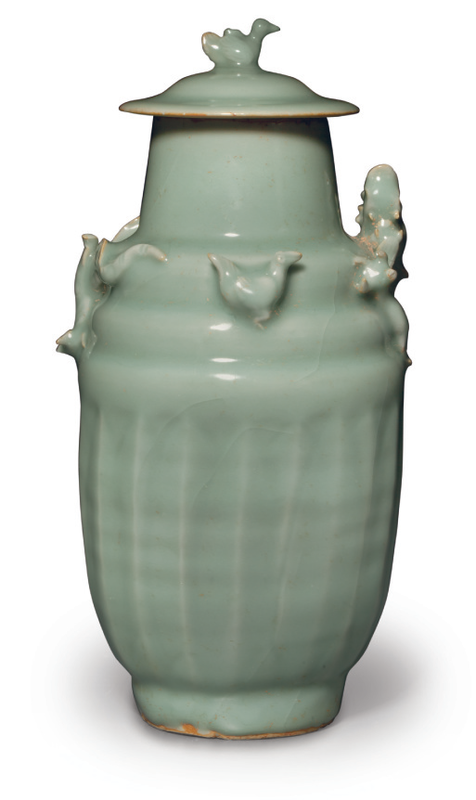A Longquan celadon 'Dragon' jar and cover, Southern Song dynasty (1127-1279)
A Longquan celadon 'Dragon' jar and cover, Southern Song dynasty (1127-1279). Estimate 150,000 – $200,000 USD. Photo Christie's Image Ltd 2015
The body is carved with upright petals below a scrolling band on the rounded shoulder which is applied with a dragon and a bird that encircle the neck below the rim. The cover is surmounted by a bird-form finial. Both are covered with an unctuous glaze of soft sea-green color that thins on the raised areas, and also covers the inside of the foot. 10 ½ in. (26.7 cm.) high, box
Provenance: T. T. Tsui Collection, Hong Kong.
Sotheby's London, 19 June 2002, lot 36.
Literature: The Tsui Museum of Art, Hong Kong, 1991, no. 45.
Notes: Covered dragon jars were popular during the Southern Song period and have been excavated from Song tombs in southern China. The conventional wisdom holds that such jars were made in pairs, one with a dragon coiled around the shoulder and known as a panlong ping, or 'coiled-dragon jar', and the other with a tiger around the shoulder and known as a panhu ping, or 'coiled-tiger jar'. Likely filled with grains, other foods, or aromatic oils, their contents offered sustenance to the spirit of the deceased and eased its passage to the next life.
The dragon-and-tiger imagery reflects Daoist directional symbolism, in which a green dragon represents the east, a red phoenix the south, a white tiger the west, and a black intertwined snake and tortoise the north. According to the principles of fengshui, or Chinese geomancy, tombs traditionally were constructed with their entrances facing south, their backs to the north. With north and south thus clearly indicated by the tomb’s architectural orientation, the east and west walls were symbolically designated by the appropriate placement of the dragon-emblazoned and tiger-embellished jars. Imbued with less elevated symbolism, the cover’s finial typically represents a bird in flight, as on the present example, or a recumbent dog or tiger.
Suzanne G. Valenstein’s characterization of Southern Song Longquan celadon ware and the related jar in the Metropolitan Museum of Art (34.113.4) perfectly summarizes this handsome example: “Decoration on Southern Song Longquan wares is always underplayed: perhaps a few lotus petals carved on the outside of a bowl or dish or, at most a plastic decorative element that is totally appropriate to the piece. This is exemplified here by the beautifully articulated dragon that winds around the shoulder of the jar.” (Suzanne G. Valenstein, A Handbook of Chinese Ceramics, New York, Metropolitan Museum of Art, 1989, text on p. 100, dragon jar illustrated on p. 105, no. 99.)
A very similar jar, formerly in the collection of Lord Cunliffe, is published in J.J. Lally & Co., Chinese Ceramics A.D. 400–1400: Selections from an American Collection, March 19 - 31, 2007, New York, 2007, no. 19. A pair of jars in the Percival David Foundation Collection, now displayed in the British Museum, is published by Margaret Medley inIllustrated Catalogue of Celadon Wares, London: Percival David Foundation of Chinese Art, School of Oriental and African Studies, 1977, pl. IV, no. 36. An example excavated at Longquan and now in the Wenzhou Museum is published in Zhu Boqian, ed., Longquan Yao Qing Ci / Celadons from Longquan Kilns, Taipei, 1998, pl. 105. Another similar jar in the Asian Art Museum, San Francisco, (B62P147.a-.b) is illustrated in He Li, Chinese Ceramics: A New Comprehensive Survey from the Asian Art Museum of San Francisco, New York, 1996, no. 281. A slightly smaller example is pictured in Illustrated Catalogue of Tokyo National Museum: Chinese Ceramics, vol. 1, Tokyo, 1988, no. 509. The somewhat simpler dragon jar in the Eli Lilly Collection and now in the Indianapolis Museum of Art (47.141) is published in Yutaka Mino and James Robinson, Beauty and Tranquility: The Eli Lilly Collection of Chinese Art,Indianapolis, 1983, pl. 78.
Robert D. Mowry,
Alan J. Dworsky Curator of Chinese Art Emeritus, Harvard Art Museums, and Senior Consultant, Christie’s
Christie's. FINE CHINESE CERAMICS AND WORKS OF ART, 17 - 18 September 2015, New York, Rockefeller Plaza

/https%3A%2F%2Fprofilepics.canalblog.com%2Fprofilepics%2F1%2F0%2F100183.jpg)
/https%3A%2F%2Fstorage.canalblog.com%2F03%2F02%2F119589%2F96711876_o.jpg)
/https%3A%2F%2Fstorage.canalblog.com%2F11%2F31%2F119589%2F94773502_o.jpg)
/https%3A%2F%2Fstorage.canalblog.com%2F20%2F83%2F119589%2F94772815_o.jpg)
/https%3A%2F%2Fstorage.canalblog.com%2F26%2F72%2F119589%2F75604929_o.jpg)
/https%3A%2F%2Fstorage.canalblog.com%2F59%2F60%2F119589%2F26458628_o.jpg)




/http%3A%2F%2Fstorage.canalblog.com%2F76%2F98%2F119589%2F129048212_o.png)
/http%3A%2F%2Fstorage.canalblog.com%2F13%2F75%2F119589%2F129042229_o.png)
/http%3A%2F%2Fstorage.canalblog.com%2F02%2F43%2F119589%2F126917236_o.jpg)
/http%3A%2F%2Fstorage.canalblog.com%2F38%2F46%2F119589%2F126901696_o.jpg)